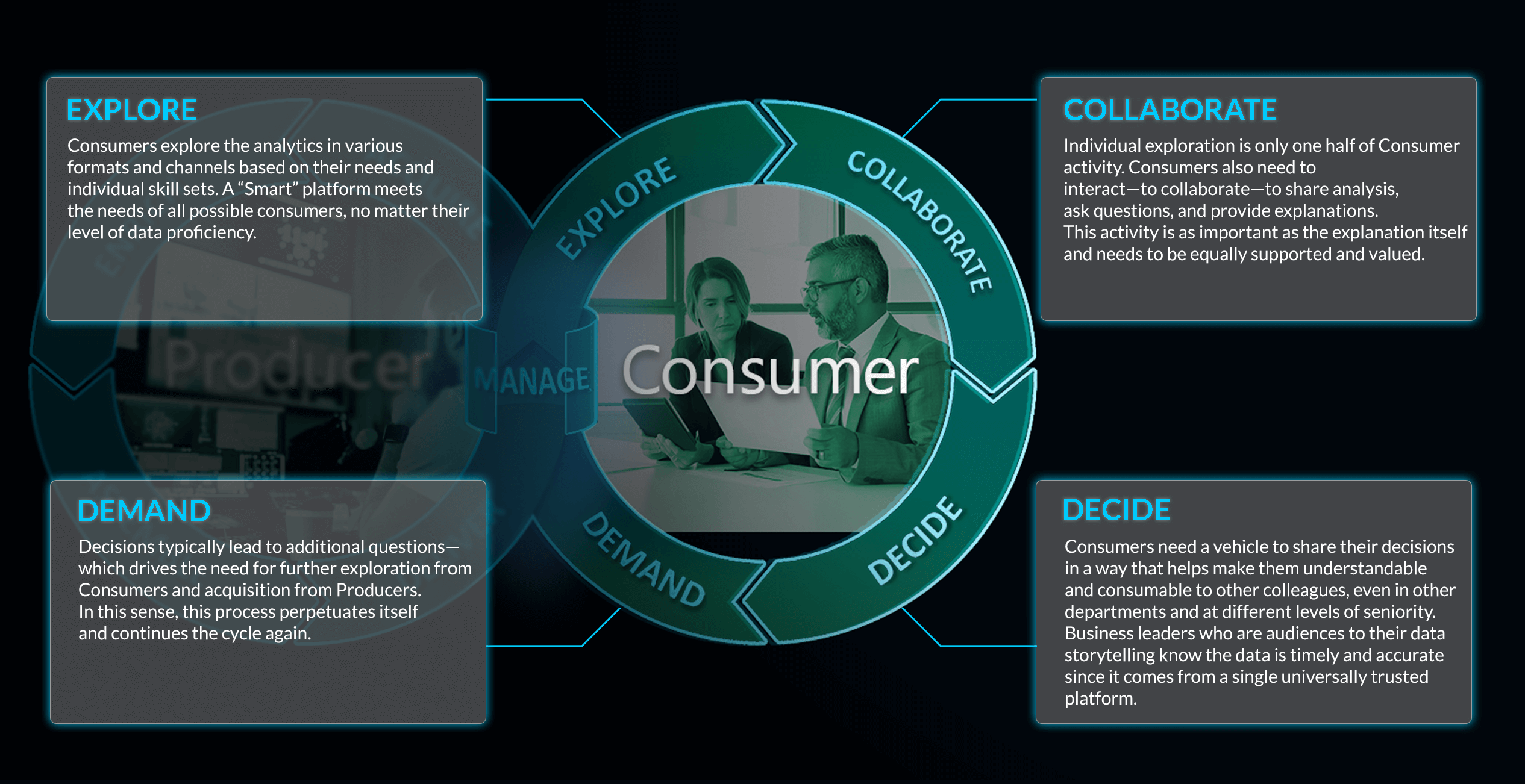A business decision supply chain contains a sequence of processes through which data owners (producers) can transform raw data into trusted and actionable business information for themselves and other users (consumers) to help make better business decisions. When integrated into a modern, cloud-ready, self-service analytics platform, users across the organization can collaborate with data to experience transformative changes.
No matter their role, employees with access to data-driven insights drive competitive benefits for their companies. But facilitating this access is easier said than done. The complexity of data and complications in delivering the right insights to the right employees not only limits access in most companies but also jeopardizes the integrity of data and ultimately, employees’ trust.
In an earlier post, I introduced the concept of the Business Decision Supply Chain, a sequence of processes by which analytics producers turn raw data into trusted and actionable business information for analytics consumers. In a second post, I began to unpack the different parts of the supply chain, highlighting the four responsibilities of modern analytics producers and data consumers.
In part 3, we explored how analytics producers can transform raw data and supply it through a variety of purpose-built distribution channels, improving the speed with which analytics consumers leverage those insights for successful decision-making.
In this article, we’ll identify the key processes by which the full population of analytics consumers—executives, line managers, business analysts, and regional managers—can explore and leverage that information to make critical decisions and improve company performance. Critically, we will uncover how they can effectively collaborate with analytics producers, enabling them to adjust and meet new business demands as well.
Both exploring data and communicating with analytics producers are essential components of the analytics consumers’ role within the business decision supply chain: the sequence of processes by which data producers turn raw data into trusted, actionable, and shareable business information. It’s through these processes that consumers make fast and accurate decisions, no matter what business challenges arise in their regions.

The four responsibilities of modern data and analytics consumers
Based on this new model, there are also four distinct activities in which consumers engage. They are:
- Explore: Consumers explore the analytics in various formats and channels based on their needs and individual skill sets. A “Smart” platform meets the needs of all possible consumers, no matter their level of data proficiency.
- Collaborate: Individual exploration is only one-half of consumer activity. Consumers also need to interact—to collaborate—to share analysis, ask questions, and provide explanations. This activity is as important as the explanation itself and needs to be equally supported and valued.
- Decide: Consumers need a vehicle to share their decisions in a way that helps make them understandable and consumable to other colleagues, even in other departments and at different levels of seniority. Business leaders who are audiences to their data storytelling know the data is timely and accurate since it comes from a single universally trusted platform.
- Demand: Decisions typically lead to additional questions—which drives the need for further exploration from consumers and acquisition from producers. In this sense, this process perpetuates itself and continues the cycle again.
When analytics is consistently delivered to the right consumers in actionable formats they understand, they consistently make better decisions to meet new business challenges.
Ways you can improve business decision-making across your organization
Even in 2021, companies continue to wrestle with analytics shortcomings that inhibit collaboration, undermine trust, and paralyze effective decision-making among their data consumers.
With the right vertically integrated platform in place, you can invigorate your business decision supply chain by applying four key processes among your data consumers. Consider how these efforts can improve decision-making, drive innovation, and even boost revenue opportunities quickly and effectively at your organization.
1. Improve how consumers collaborate and access insights from analytics
Analytics consumers need practical ways to collaborate with the analytics-producer side of the business decision supply chain. Providing consumers with an intuitive, connected, purpose-built interface makes this possible—whether it takes the form of a dashboard in a browser or a mobile or tablet app, producers can easily understand their needs and deliver interactive data visualizations for better decisions and collaboration among data consumers. Producers can centralize data and make it available to any variety of business units at all levels in the ways that they want, without detaching that data from its original source (e.g., in an Excel file attached to an email).
In one real-world example, a leading retailer provided its employees with self-service access so that employees didn’t need to collect data themselves. Instead, they accessed new reports and dashboards on a daily or even hourly basis for analyzing their retail store traffic and determining staff levels needed to run outlets more efficiently. In another real-world example, an executive team at a leading market analysis company could acquire stronger, more up-to-date views of the financial position of their company at any given time, helping with overarching strategic decisions for their organization.
2. Empower data consumers to proactively explore data, without technical training
Modern analytics allow data consumers to retrieve data from its source with minimal cost, effort, or friction. Even as they visualize that data in practical ways, the data doesn’t need to be removed from its original, centralized source; instead, data producers facilitate its presentation in personalized ways that empower data consumers.
For one real-world online B2B marketplace, that meant providing a robust, cross-user experience where both data scientists and business users could extract valuable insights, support internal decision-making, and ultimately develop unique data products in high demand by their customers. In this way, the company’s analytics is helping them facilitate better buyer-supplier relationships within their platform, and distinguishing the company within B2B markets.
3. Optimize collaboration within the analytics environment
Just as data becomes more available and actionable, analytics consumers at all levels need access to a vertically integrated platform that improves collaboration with other consumers within the analytics environment.
With the platform in place, data consumers do not need to rely on workarounds like Excel files. They can easily work with one another, share insights, and work towards mutual objectives. They can provide different business users with unique dashboards for their own analysis, and they can also ensure all employees are “talking about the same numbers,” as the real-world leading retailer once described.
4. Provide support and self-service capabilities for successful everyday decision-making
Analytics consumers’ top goal is to understand business complexity and make confident decisions with trusted data. Just as important is making successful decisions quickly based on the constantly shifting requirements of the market. The modern vertically integrated analytics allows for superior data integrity as well as rapid delivery of insights across all users even as individual business conditions evolve in different ways.
In the case of the leading retailer, these capabilities allowed them to increase stock availability in their stores by 5%, freeing up millions of additional cash from turnover. For the leading market analysis company, once-quarterly reports painstakingly assembled for their executive finance team are now produced monthly with ease. In both cases, stakeholders achieve ease of data accessibility and timely visibility into essential insights where before there was none.
Simplifying data consumer access, even as you scale
Perhaps the final and arguably most critical aspect of any analytics platform is its ability to facilitate future company growth, including the proliferation of data sources. That means data pulled from a growing number of business streams—merchandise management, financial, e-commerce, manufacturing—shared seamlessly across the whole enterprise, without leaving its dedicated environment.
Pyramid Analytics provides unmatched, browser-based self-service capabilities to data consumers, who can configure their individual experiences based on their own ability. As users’ needs change, their analytics skills evolve, or their needs for data access change, they can easily adjust their interfaces to meet new demand.
Contact us to learn more about boosting collaboration and decision-making among your data Consumers and start driving competitive business value in your industry today.
This post is a part of our five-part series on the Business Decision Supply Chain. Revisit any of the other posts to learn more:













